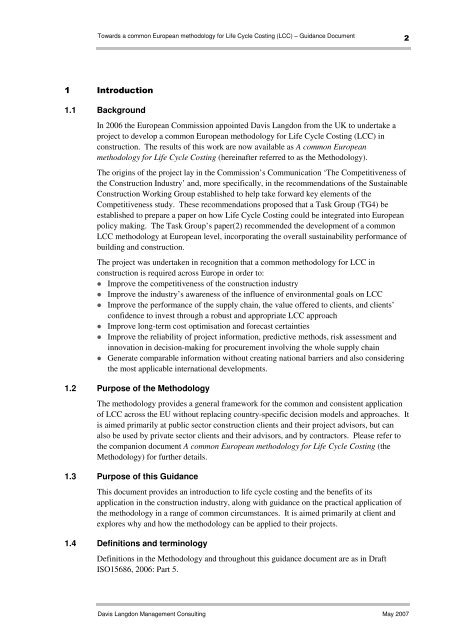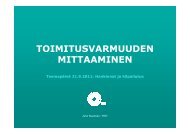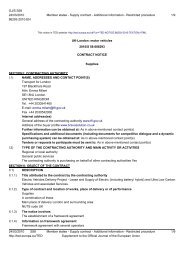Life cycle costing (LCC) as a contribution to sustainable construction ...
Life cycle costing (LCC) as a contribution to sustainable construction ...
Life cycle costing (LCC) as a contribution to sustainable construction ...
You also want an ePaper? Increase the reach of your titles
YUMPU automatically turns print PDFs into web optimized ePapers that Google loves.
Towards a common European methodology for <strong>Life</strong> Cycle Costing (<strong>LCC</strong>) – Guidance Document<br />
2<br />
1 Introduction<br />
1.1 Background<br />
In 2006 the European Commission appointed Davis Langdon from the UK <strong>to</strong> undertake a<br />
project <strong>to</strong> develop a common European methodology for <strong>Life</strong> Cycle Costing (<strong>LCC</strong>) in<br />
<strong>construction</strong>. The results of this work are now available <strong>as</strong> A common European<br />
methodology for <strong>Life</strong> Cycle Costing (hereinafter referred <strong>to</strong> <strong>as</strong> the Methodology).<br />
The origins of the project lay in the Commission’s Communication ‘The Competitiveness of<br />
the Construction Industry’ and, more specifically, in the recommendations of the Sustainable<br />
Construction Working Group established <strong>to</strong> help take forward key elements of the<br />
Competitiveness study. These recommendations proposed that a T<strong>as</strong>k Group (TG4) be<br />
established <strong>to</strong> prepare a paper on how <strong>Life</strong> Cycle Costing could be integrated in<strong>to</strong> European<br />
policy making. The T<strong>as</strong>k Group’s paper(2) recommended the development of a common<br />
<strong>LCC</strong> methodology at European level, incorporating the overall sustainability performance of<br />
building and <strong>construction</strong>.<br />
The project w<strong>as</strong> undertaken in recognition that a common methodology for <strong>LCC</strong> in<br />
<strong>construction</strong> is required across Europe in order <strong>to</strong>:<br />
Improve the competitiveness of the <strong>construction</strong> industry<br />
Improve the industry’s awareness of the influence of environmental goals on <strong>LCC</strong><br />
Improve the performance of the supply chain, the value offered <strong>to</strong> clients, and clients’<br />
confidence <strong>to</strong> invest through a robust and appropriate <strong>LCC</strong> approach<br />
Improve long-term cost optimisation and forec<strong>as</strong>t certainties<br />
Improve the reliability of project information, predictive methods, risk <strong>as</strong>sessment and<br />
innovation in decision-making for procurement involving the whole supply chain<br />
Generate comparable information without creating national barriers and also considering<br />
the most applicable international developments.<br />
1.2 Purpose of the Methodology<br />
The methodology provides a general framework for the common and consistent application<br />
of <strong>LCC</strong> across the EU without replacing country-specific decision models and approaches. It<br />
is aimed primarily at public sec<strong>to</strong>r <strong>construction</strong> clients and their project advisors, but can<br />
also be used by private sec<strong>to</strong>r clients and their advisors, and by contrac<strong>to</strong>rs. Ple<strong>as</strong>e refer <strong>to</strong><br />
the companion document A common European methodology for <strong>Life</strong> Cycle Costing (the<br />
Methodology) for further details.<br />
1.3 Purpose of this Guidance<br />
This document provides an introduction <strong>to</strong> life <strong>cycle</strong> <strong>costing</strong> and the benefits of its<br />
application in the <strong>construction</strong> industry, along with guidance on the practical application of<br />
the methodology in a range of common circumstances. It is aimed primarily at client and<br />
explores why and how the methodology can be applied <strong>to</strong> their projects.<br />
1.4 Definitions and terminology<br />
Definitions in the Methodology and throughout this guidance document are <strong>as</strong> in Draft<br />
ISO15686, 2006: Part 5.<br />
Davis Langdon Management Consulting May 2007







